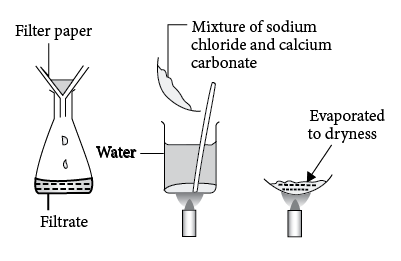
A mixture of sodium chloride and calcium carbonate is separated using the steps given. In which order should the steps be carried out?

A.1,2 then 3
B.2,1 then 3
C.1,3 then 2
D.3,1 then 2

Answer
418.8k+ views
Hint: We have to know that sodium Chloride is a colourless/white salt that is formed by the reaction of
Complete answer:
Now we can discuss about the separation process of two salts can be done in two ways:
Physical Separation: Physical separation methods, such as filtration and distillation, are based on the difference in particle size, the boiling point of the substances, etc
Chemical Separation: It is based purely on the chemical properties of the substances, such as solubility etc.
We have been given two salts; Sodium chloride and Calcium Carbonate. Out of which Sodium Chloride is water soluble and Calcium Carbonate is water insoluble. Thus, this difference in solubility is used for the separation of these compounds.
Therefore, the separation process will go as follows:
STEP 1: The mixture of both the salts are dissolved in water.
STEP 2: This Heterogenous Mixture (since it contains solid and liquid) can be separated by using Filtration Technique. The mixture is made to pass through Filter Paper and Calcium Carbonate is separated and
STEP 3: Sodium Chloride is now obtained back by the process of evaporation. The filtrate is placed on a burner until all the water evaporates and we get pure sodium chloride back.
Hence the Correct Answer is: Option (B).
Note:
Here, Calcium Carbonate is insoluble in water because of the High Lattice Energy. High amount of energy is required to break these bonds. Moreover, if two water soluble salts are given, they are separated using advanced techniques like crystallization and Vacuum Distillation.
Complete answer:
Now we can discuss about the separation process of two salts can be done in two ways:
Physical Separation: Physical separation methods, such as filtration and distillation, are based on the difference in particle size, the boiling point of the substances, etc
Chemical Separation: It is based purely on the chemical properties of the substances, such as solubility etc.
We have been given two salts; Sodium chloride and Calcium Carbonate. Out of which Sodium Chloride is water soluble and Calcium Carbonate is water insoluble. Thus, this difference in solubility is used for the separation of these compounds.
Therefore, the separation process will go as follows:
STEP 1: The mixture of both the salts are dissolved in water.
STEP 2: This Heterogenous Mixture (since it contains solid and liquid) can be separated by using Filtration Technique. The mixture is made to pass through Filter Paper and Calcium Carbonate is separated and
STEP 3: Sodium Chloride is now obtained back by the process of evaporation. The filtrate is placed on a burner until all the water evaporates and we get pure sodium chloride back.
Hence the Correct Answer is: Option (B).
Note:
Here, Calcium Carbonate is insoluble in water because of the High Lattice Energy. High amount of energy is required to break these bonds. Moreover, if two water soluble salts are given, they are separated using advanced techniques like crystallization and Vacuum Distillation.
Recently Updated Pages
Master Class 9 General Knowledge: Engaging Questions & Answers for Success

Master Class 9 English: Engaging Questions & Answers for Success

Master Class 9 Science: Engaging Questions & Answers for Success

Master Class 9 Social Science: Engaging Questions & Answers for Success

Master Class 9 Maths: Engaging Questions & Answers for Success

Class 9 Question and Answer - Your Ultimate Solutions Guide

Trending doubts
State and prove Bernoullis theorem class 11 physics CBSE

What are Quantum numbers Explain the quantum number class 11 chemistry CBSE

Who built the Grand Trunk Road AChandragupta Maurya class 11 social science CBSE

1 ton equals to A 100 kg B 1000 kg C 10 kg D 10000 class 11 physics CBSE

State the laws of reflection of light

One Metric ton is equal to kg A 10000 B 1000 C 100 class 11 physics CBSE




